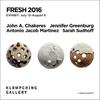Exhibition of Modern and Contemporary Bamboo Works Opening at The Met June 13
- NEW YORK, New York
- /
- May 17, 2017
A spectacular loan exhibition devoted to masterworks of Japanese bamboo art—including award-winning works by six artists who were designated as Living National Treasures—will go on view at The Metropolitan Museum of Art beginning June 13.
Featuring more than 90 works dating from the late 19th century to the present, Japanese Bamboo Art: The Abbey Collection will explore the refined beauty and technical sophistication of Japanese bamboo, which has been little known in the West until recent years. Opening with a monumental bamboo sculpture by Tanabe Chikuunsai IV (b. 1973)—a site-specific installation created for The Met—the exhibition will highlight key stages in the modern history of Japanese bamboo art while introducing the main lineages of bamboo masters and showing the emergence of a contemporary bamboo art. The Diane and Arthur Abbey Collection is one of the finest assemblages of Japanese baskets and bamboo sculpture in private hands. The majority of the works have never before been presented to the public, and more than 70 are recent promised gifts to The Met.
For hundreds of years, simple, everyday utensils as well as refined bamboo vessels were made according to local traditions and techniques passed down from generation to generation. It was not until the end of the 19th century that bamboo craftsmanship began to be recognized as one of the traditional Japanese decorative arts, and later as an art form.
Organized broadly by three geographical production areas—Kansai, Kanto, and Kyushu—the exhibition will feature masterworks by pioneer bamboo artists of the Meiji (1868–1912) and Taisho (1912–1926) periods as well as later masters such as Iizuka Rokansai, who created innovative works that became the foundation for contemporary bamboo art. The show will also feature pieces by modern bamboo artists. The works will be augmented by a selection of paintings and decorative arts exploring related themes, such as the four seasons, floral compositions (ikebana), and the tea ceremony. Establishing lineages in order to pass down techniques and styles to disciples is a long-standing tradition among prominent artists in Japan, and many of the leading bamboo craftsmen founded their own schools, most of which are still active today.
The exhibition will demonstrate the transmission of the tradition through works created by the four masters of the Hayakawa lineage and four generations of the Tanabe Chikuunsai family. Highlights of the exhibition include Basket for transporting sencha tea ceremony utensils (ca. 1877–80s), by Hayakawa Shōkosai I (1815-1897), who is believed to be the first basket master craftsman to sign his works; Moon reflected on water (1929), by Sakaguchi Sōunsai (1899–1967), which is the first bamboo work accepted into a public, government-sponsored art exhibition, in 1929; Offering or fruit tray with intersecting circles design (ca. 1947), made of smoked timber bamboo and an early work by Shōno Shōunsai (1904-1974), who, in 1967, became the first Living National Treasure of bamboo art; a refined, conceptual piece, Autumn breeze (2014), by Uematsu Chikuyu (b. 1947); and Flowing pattern (2014), an award-winning piece that incorporates a flexible bamboo species called men'yadake and is by Honma Hideaki (b. 1959), who began studying bamboo art with his father, Honma Kazuaki, after losing sight in one eye while serving in the Japanese Air Force.
Long-time New York residents Diane and Arthur Abbey started collecting Japanese bamboo art, along with Western contemporary art, in the 1990s. Their collection of more than 200 baskets and bamboo sculpture encompasses pieces made in the late 19th century through masterworks of the postwar period created by Living National Treasure artists.
The exhibition is organized by Monika Bincsik, Assistant Curator in the Department of Asian Art at The Met.
The exhibition will be featured on The Met website.
















